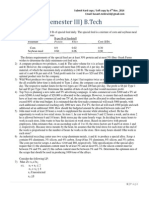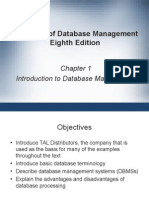Professional Documents
Culture Documents
Coursera
Coursera
Uploaded by
aanchalOriginal Description:
Original Title
Copyright
Available Formats
Share this document
Did you find this document useful?
Is this content inappropriate?
Report this DocumentCopyright:
Available Formats
Coursera
Coursera
Uploaded by
aanchalCopyright:
Available Formats
About Coursera & Brief History
Coursera was founded in 2012 by two Stanford University Computer Science
professors- Daphne Koller and Andrew Ng to share their knowledge and skills with
the world.
Andrew taught Machine Learning and had 400 people enrolled and when the course
was opened up to the general public, 100,000 people enrolled for the same. For him to
reach the same size and make it possible, he had to do that for roughly 250 years.
Since then, they decided to build a platform where anyone, anywhere can learn and
earn credentials from the world’s top universities and education providers.
Coursera offers a wide variety of courses in various fields. These classes are
typically scheduled and run between 4-10 weeks with video lectures, reading
assignments and quizzes along the way.
All students sign an honour code, pledging not to cheat, plagiarize or engage in
unethical academic behaviour and are encouraged to participate in web forums The
biometric analysis of keystrokes and the use of webcams during exams help ensure
the identity of test takers for those earning certificates.
Coursera now offers courses through their website as well as via their mobile app.
Business Model
The initial value creation model assumed that people crave knowledge and want to continue
to attain information and skills in a wide array of topics. And even though MOOCS were
labelled higher education killers and potential brand diluters, they also created value for
academic institutions that saw the potential for a new, future revenue stream.
Initially, Coursera offered classes free of charge with the future intent to test out creative
monetization strategies. The MOOC provider is moving towards the following revenue-
generating strategies:
1. Fee-based courses which require students to pay a fee for access to graded
assignments.
2. Specializations, a sequence of courses with a capstone project.
3. Course Certificates (formerly known as Signature Track).
In addition to charging optional tuition fees, Coursera's monetization strategy includes
providing networking opportunities that introduce its students to potential employers and
recruiters. Employers can also pay for access to valuable student information – with their
consent – such as performance metrics and demographic information.
Other sources of revenue may include:
Enrolled students can pay for human-provided tutoring services to help them in
trouble areas.
Enterprise versions of the platform may be sold to companies, governments or other
organizations for professional training and certification.
Coursera may sell advertisements on their website/app or offer official
course/specialization sponsorships.
Coursera could license their identity-verified testing services for secure assessments
to end users.
Growth
Analysis & Conclusion
Since 4 years of its founding, Coursera learnt a hard lesson– both value creation and value
capture did not work.
Students churned out of the product and the course completion rate was extremely
low.
The life-long learning value proposition wasn’t as strong as assumed – most students
wanted to see something for their work (a credential, a new job, etc.)
This lack of value creation prevented Coursera from benefitting from any potential
network effects.
Multihoming was rampant
Coursera found it hard to capture value in this context so it refocused on three things:
Create more value for users with improved product quality – They worked to improve
student-professor and student-student interaction, tied up with good universities and
increased product offering. They hired a former Netflix product executive rethink
Coursera’s search and course recommendation functions with the goal of driving
tailored content to users based on their learning needs.
Reduce multihoming via a subscription offering
Capture more value through an enterprise business model – Coursera has built a B2B
platform and is going after the corporate and workforce training via partnerships with
corporations and governments. Coursera, in keeping with its mission, will maintain its
B2C business, but it has realized that more money is on the enterprise side right now.
Coursera has worked its way to the Forbes’ 2018 Next Billion-Dollar Startup list to cross into
unicorn territory. Current growth trajectory includes expansion around the world. After the
U.S., Coursera’s greatest growth has come from India, China, Mexico and Brazil.
The latest investment in Coursera was led by SEEK Group, an Australian company with
stakes in online employment and education firms. SEEK was joined by previous Coursera
investors Future Fund and NEA. It brings Coursera’s total funding to $313 million.
It is, therefore, moving down a profitable path. Moving forward, it should continue
to differentiate their platform from competitors, consider strategic use of the data the
platform is collecting and encourage third party developers to enrich the Coursera
community.
You might also like
- Assignment#1 Leadership Skills Analysis INDIVIDUAL 4Document3 pagesAssignment#1 Leadership Skills Analysis INDIVIDUAL 4Ehigie MOMODUNo ratings yet
- Waiting For A Sales Renaissance in The Fourth Industrial RevolutionDocument12 pagesWaiting For A Sales Renaissance in The Fourth Industrial RevolutionTemato pro10No ratings yet
- Professional Ethics - Course PresentationDocument53 pagesProfessional Ethics - Course PresentationMichael MwateNo ratings yet
- Taking Supplier Collaboration To The Next LevelDocument11 pagesTaking Supplier Collaboration To The Next LevelparsadNo ratings yet
- HRM - Group 7 FinalDocument15 pagesHRM - Group 7 FinalsoumyaNo ratings yet
- HKTVmall PPT - Pre170919Document41 pagesHKTVmall PPT - Pre170919as7No ratings yet
- Re-Engineering The Corporation - Presenting The Book by Hammer and ChampyDocument39 pagesRe-Engineering The Corporation - Presenting The Book by Hammer and Champynaveenkumarubs100% (1)
- Coursera AnalysisDocument20 pagesCoursera AnalysisKaran ChhabraNo ratings yet
- DigitalGenius Guide Customer Service and Artificial Intelligence PDFDocument11 pagesDigitalGenius Guide Customer Service and Artificial Intelligence PDFraphaelNo ratings yet
- Eth 5618 02Document165 pagesEth 5618 02ranjeetsoni0% (1)
- Integrative FrameworkDocument17 pagesIntegrative Frameworkkatee3847No ratings yet
- Explaining The Consumer Decision-Making Process Critical Literature Review JIBRM PDFDocument8 pagesExplaining The Consumer Decision-Making Process Critical Literature Review JIBRM PDFNikhil PatilNo ratings yet
- Mindfulness at Work Resource ModelDocument19 pagesMindfulness at Work Resource Modeleman khalidNo ratings yet
- HR Outsourcing Threat or Opp Port UnityDocument21 pagesHR Outsourcing Threat or Opp Port UnityJustissaNo ratings yet
- Define Ethics: Dictionary Definition of EthicsDocument18 pagesDefine Ethics: Dictionary Definition of EthicsPrudhvinadh KopparapuNo ratings yet
- Hello FreshDocument9 pagesHello FreshJoud ZaneedNo ratings yet
- Services Marketing - DR Anupam NarulaDocument5 pagesServices Marketing - DR Anupam NarulaHimangi MalikNo ratings yet
- Spare Parts Pricing OptimizationDocument11 pagesSpare Parts Pricing OptimizationParlin BNNo ratings yet
- After-Sales Services and Aftermarket Support: A Systematic Review, Theory and Future Research DirectionsDocument27 pagesAfter-Sales Services and Aftermarket Support: A Systematic Review, Theory and Future Research DirectionsYannah Hidalgo100% (1)
- 5dbdcadfc4731 Hul TechtonicDocument1 page5dbdcadfc4731 Hul TechtonicARVINDNo ratings yet
- Code of Ethics in BusinessDocument4 pagesCode of Ethics in BusinessJannah Nicole Devera RazonableNo ratings yet
- Rocking The Daisies - 2011 & 2012 - Case StudyDocument6 pagesRocking The Daisies - 2011 & 2012 - Case StudyPooja ShettyNo ratings yet
- Assignment Stid (Group 18) - Big DataDocument28 pagesAssignment Stid (Group 18) - Big DatanurfarzanaNo ratings yet
- Tesco ConclusionDocument1 pageTesco ConclusionHimanshu OzaNo ratings yet
- An Organisational Study of Amalgamated Bean Coffee Trading Company Limited, Chennai.Document41 pagesAn Organisational Study of Amalgamated Bean Coffee Trading Company Limited, Chennai.Gomathi GanesanNo ratings yet
- ABC in BankDocument43 pagesABC in Bankmuhaayan0% (1)
- UMACRQ-15-M Strategic Management Accounting: Session 6: Activity-Based Costing (ABC) RevisitedDocument24 pagesUMACRQ-15-M Strategic Management Accounting: Session 6: Activity-Based Costing (ABC) RevisitedAhmed MunawarNo ratings yet
- Solution For Online Ad Targeting at ThunderbirdDocument7 pagesSolution For Online Ad Targeting at ThunderbirdShubham RajNo ratings yet
- Introduction To Green RetailDocument7 pagesIntroduction To Green RetailDegusa PatelNo ratings yet
- Self-Development PortfolioDocument19 pagesSelf-Development Portfolioaries usamaNo ratings yet
- Ch.6 Corporate Social Responsibility: Basic Premises of CSRDocument11 pagesCh.6 Corporate Social Responsibility: Basic Premises of CSRAdrian Dale DavidNo ratings yet
- Digital Optimisation Module SpecDocument9 pagesDigital Optimisation Module Specramzan aliNo ratings yet
- 1 What Challenges Does Coach Face Relative To Pricing ItsDocument1 page1 What Challenges Does Coach Face Relative To Pricing ItsCharlotteNo ratings yet
- Experiential Exercise 8ADocument13 pagesExperiential Exercise 8AAtiqah Binti Abu Hassan100% (1)
- Business Ethics: "It Is The Mark of An Educated Mind To Be Able To Entertain A Thought Without Accepting It."Document23 pagesBusiness Ethics: "It Is The Mark of An Educated Mind To Be Able To Entertain A Thought Without Accepting It."Jotdeep SinghNo ratings yet
- Breaking Free From ProductDocument14 pagesBreaking Free From ProductAhmadNo ratings yet
- The Forrester Wave™: Data Management Platforms, Q3 2013: Key TakeawaysDocument13 pagesThe Forrester Wave™: Data Management Platforms, Q3 2013: Key TakeawaysinerimNo ratings yet
- Smartphones in The Workplace - Changing Organizational Behavior Transforming The FutureDocument11 pagesSmartphones in The Workplace - Changing Organizational Behavior Transforming The Futurecharlie simoNo ratings yet
- SAP Marketing CaseDocument3 pagesSAP Marketing CaseSoumya BarmanNo ratings yet
- XINE249 BBM Sample SyllabusDocument0 pagesXINE249 BBM Sample SyllabuslilbouyinNo ratings yet
- Mathematics in The Modern WorldDocument6 pagesMathematics in The Modern WorldCrispin Jun EspeletaNo ratings yet
- Mini CaseDocument7 pagesMini Caseayush100% (1)
- Sharon Bell Courses Fall 2013Document5 pagesSharon Bell Courses Fall 2013Sumenep MarketingNo ratings yet
- Why Sustainable Marketing Is Important For Your Business PDFDocument6 pagesWhy Sustainable Marketing Is Important For Your Business PDFDilnesa AbrahamNo ratings yet
- Consulting Frameworks You Must Know 1693625327Document11 pagesConsulting Frameworks You Must Know 1693625327Aditya SinhaNo ratings yet
- A Policy Framework For Community Telecentres in India - Building On The Experience of Different ProjectsDocument8 pagesA Policy Framework For Community Telecentres in India - Building On The Experience of Different ProjectsIT for ChangeNo ratings yet
- FIVE Force ModelDocument12 pagesFIVE Force Modelsubhash321No ratings yet
- Stewarding Multiple ChannelsDocument21 pagesStewarding Multiple ChannelsSohaib ArifNo ratings yet
- B2B Relationship MarketingDocument53 pagesB2B Relationship MarketingSoumit MondalNo ratings yet
- Consumer Behaviour Analysis - Nescafe: ApproachDocument3 pagesConsumer Behaviour Analysis - Nescafe: ApproachKumar PawarNo ratings yet
- Quality Management: Ravindra S. Gokhale IIM IndoreDocument42 pagesQuality Management: Ravindra S. Gokhale IIM IndoreSibe ShanmugamNo ratings yet
- Parle Products PVTDocument13 pagesParle Products PVTrathod30No ratings yet
- NotesDocument7 pagesNoteschady.ayrouthNo ratings yet
- Case Chapter 11: Management Information SystemsDocument12 pagesCase Chapter 11: Management Information SystemsAnonymous zxzokTrX2ONo ratings yet
- Project FinanceDocument2 pagesProject FinanceSaquib AzamNo ratings yet
- Teaching and Learning Digital AgeDocument21 pagesTeaching and Learning Digital Agetummalapalli venkateswara raoNo ratings yet
- CRM 1.PPT LectureDocument9 pagesCRM 1.PPT Lectureashishdwivedi23100% (1)
- Digital Marketing ExecutiveDocument3 pagesDigital Marketing ExecutivenaviNo ratings yet
- Expatriate Management NotesDocument8 pagesExpatriate Management Notesanshu chaurasiaNo ratings yet
- Open Source Customer Relationship Management Solutions: Potential for an Impact of Open Source CRM Solutions on Small- and Medium Sized EnterprisesFrom EverandOpen Source Customer Relationship Management Solutions: Potential for an Impact of Open Source CRM Solutions on Small- and Medium Sized EnterprisesNo ratings yet
- Design and Implementation of Efficient 4x4 Vedic Multiplier For DSP ApplicationsDocument6 pagesDesign and Implementation of Efficient 4x4 Vedic Multiplier For DSP Applicationsrakesh hiremathNo ratings yet
- Fra801G Thru Fra807G: 8.0 AMPS. Glass Passivated Fast Recovery RectifiersDocument2 pagesFra801G Thru Fra807G: 8.0 AMPS. Glass Passivated Fast Recovery RectifiersJose Luis LopezNo ratings yet
- C2 ListingDocument1 pageC2 ListingPrashanthArathiShineyNo ratings yet
- Index: NotebookDocument28 pagesIndex: NotebookLeah MandigmaNo ratings yet
- Wireless Smart Home Network ProposalDocument5 pagesWireless Smart Home Network Proposalesse_clark100% (1)
- Research, The Negative Effects of Social Media in Students Academic PerformanceDocument49 pagesResearch, The Negative Effects of Social Media in Students Academic PerformancedayanandorynjaneNo ratings yet
- Lab 2Document16 pagesLab 2Sadia BilalNo ratings yet
- Siemens Aristos FX - Datasheet (Eng)Document12 pagesSiemens Aristos FX - Datasheet (Eng)StanTofeNo ratings yet
- Fog Volume 3.4Document116 pagesFog Volume 3.4BattleAppleNo ratings yet
- Common Platform Enumeration: Applicability Language Specification Version 2.3 (NISTIR 7698)Document23 pagesCommon Platform Enumeration: Applicability Language Specification Version 2.3 (NISTIR 7698)FedScoopNo ratings yet
- Advertisement For Teaching and Non Teaching Positions, IIIT NagpurDocument8 pagesAdvertisement For Teaching and Non Teaching Positions, IIIT NagpurVerma AbhiNo ratings yet
- 2018 Chem KIPS Tests+KeysDocument70 pages2018 Chem KIPS Tests+KeysMohammad Tayyab100% (1)
- Probecard Pin Technology Selection and Design Process - Test Technology Confluence Page - ConfluenceDocument10 pagesProbecard Pin Technology Selection and Design Process - Test Technology Confluence Page - ConfluenceAlainckv MaligadNo ratings yet
- Lighting Control: 4. Interface With Other SystemsDocument2 pagesLighting Control: 4. Interface With Other SystemsVinay PallivalppilNo ratings yet
- PricelistDocument6 pagesPricelistsumitvfx87No ratings yet
- HWCH 03Document3 pagesHWCH 03Mia KulalNo ratings yet
- NetbackupDocument3 pagesNetbackupKiran KumarNo ratings yet
- Data Structures and Algorithms With Python LetsUpgradeDocument11 pagesData Structures and Algorithms With Python LetsUpgradePredator 1No ratings yet
- Fire Detecting Robots PPT SeminarsDocument17 pagesFire Detecting Robots PPT Seminarssatyam_venkat02350% (2)
- Irf 510Document7 pagesIrf 510hayatdoluusNo ratings yet
- CRMA: Collision-Resistant Multiple AccessDocument12 pagesCRMA: Collision-Resistant Multiple AccessFernanda Sousa NascimentoNo ratings yet
- Ps2 Keyboard To Usb Wiring Diagram - DavehaynesmeDocument12 pagesPs2 Keyboard To Usb Wiring Diagram - Davehaynesmeamay supriatnaNo ratings yet
- Renewable Energy & Emerging Trends in Electronics: Course Code: 4361106Document9 pagesRenewable Energy & Emerging Trends in Electronics: Course Code: 4361106rashmin tannaNo ratings yet
- Sap BoDocument4 pagesSap BoJorge ThomasNo ratings yet
- CSS 11 EXAM 1st-2nd SemDocument2 pagesCSS 11 EXAM 1st-2nd Semjanry ogatis100% (1)
- Rel 5Document17 pagesRel 5burakNo ratings yet
- Lab#9 (Common Emitter Amplifier)Document6 pagesLab#9 (Common Emitter Amplifier)Muhammad HamzaNo ratings yet
- Assignment B TechDocument5 pagesAssignment B TechAbhishekKumarNo ratings yet
- MR Rahul KumarDocument4 pagesMR Rahul KumarRay EddyNo ratings yet
- Concepts of Database Management Eighth EditionDocument47 pagesConcepts of Database Management Eighth EditionBrandon PrattNo ratings yet

























































































